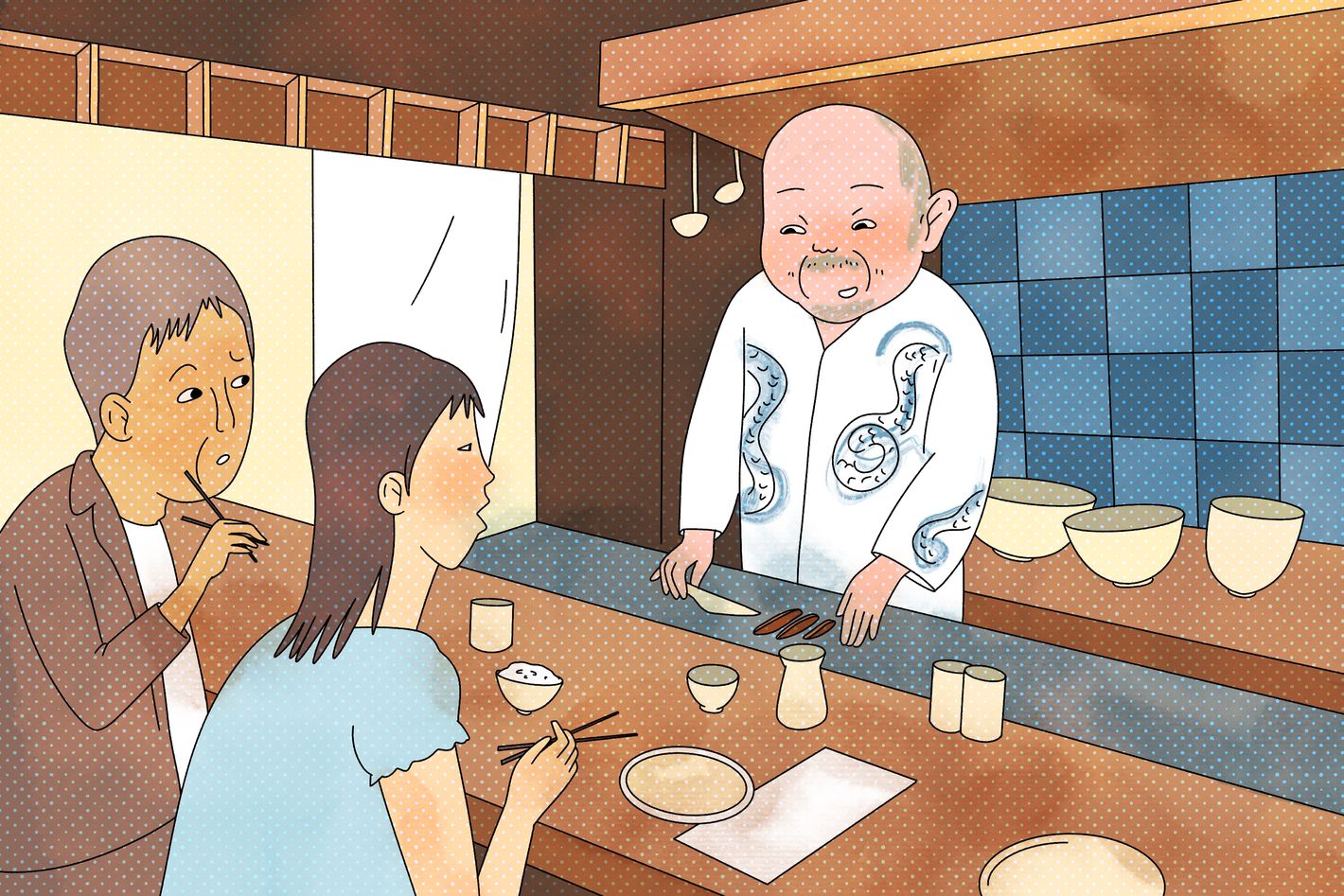when you want, where you want.
Hori Is an Invite-Only Izakaya
 Illustration: Sunny Wu
Illustration: Sunny Wu
Down a narrow flight of stairs off a nondescript stretch of East 50th Street, past a ceramics studio and behind a clothing boutique, is the 14-seat restaurant Hori. Technically, anyone is welcome inside the izakaya, divided into an eight-seat bar and a six-seat room, although reservations are required and even the most vigilant stalkers of the Resy page will find that there are not actually reservations available for the restaurant, ever. This is because Hori is possibly the only restaurant in New York that operates with the Japanese system of ichigensan okotowari — which means first-time diners must be guests of a regular. Once someone has dined and adhered to the strict “no social media” rule, they can register themselves and unlock access to the otherwise invisible reservations.
The restaurant is inside Studio Calmplex, which informed the policy, says chef Tsuyoshi Hori. “You have to go through several tenants to get here,” he explains. “We needed to find a way to be friendly with our neighbors and not be bothersome, but also find our guests. And so that’s why we started off with, ‘Oh, you can bring your friend, but make sure they understand the rules and are respectful to our neighbors.’” It worked: “It’s really the vibe of this place and the air that flows in this restaurant,” Hori adds. “The overall experience is very special.”
It was Kihyun Lee, the founder of Hand Hospitality, which runs the restaurant, who first suggested that the small, hidden izakaya could take some inspiration from the Japanese TV series (and manga it is based on) Midnight Diner, where a regular cast of characters revolve around a chef at a late-night Tokyo restaurant.
“This is what we call ‘jouren’ culture, meaning ‘regular customers,’” says Keisuke Oku, who oversees Hand Hospitality’s Japanese businesses. “If you go there, you may know some people, or you may become friends with people who dined with you.”
Oku says the model helps build a foundation of loyal customers instead of chasing customers who might only visit one or two times. “What we are trying to focus on is a sustainable business, meaning that we want customers to feel comfortable and have a great experience so that they come back and they feel they want to bring somebody,” he says.
Ichigensan okotowari is not unusual in cities like Kyoto or Tokyo, and in New York Rao’s has, of course, operated for decades with an inner circle of regular diners clutching onto nearly all of its tables and booths. But in the city, most spots wanting to cultivate an air of exclusivity do so via cold, hard cash, like the $10,000 annual membership required to dine at a private club such as Major Food Group’s ZZ’s.
“The introduction-only thing makes it sound like the place must be kind of snobby or difficult to get into, or the chef must be difficult,” says one regular, Chizuko Niikawa Helton, a sake consultant who’s already eaten at Hori three or four times. “It’s completely different. Hori-san is one of the funniest and nicest chefs in New York.”
The first time Helton walked through the ceramics studio (where Hori makes all of the restaurant’s chopstick rests) and clothing store to enter Hori, she was surprised by how casual and warm the restaurant felt — and by the reasonable prices of the food, which range from a rotating daily $1 menu item to $9.50 for Hori’s handmade soba noodles made from buckwheat that’s grown and milled on a farm in Maine. While one could potentially drop between $100 and $3,000 on Hori’s sake list, most of the menu is in the single digits, like a $4.50 potato salad topped with fried strands of soba and a $7 plate of dashimaki tamago.
“The system allows me to be a lot more playful with how I present the menu and how I play around with what I can serve each night,” says Hori. The $1 special of the night (not advertised on the written menu but available by request) might make use of a small amount of a particular vegetable the chef has. A grilled beef-tongue special recently opened an opportunity for a second special, made by simmering the tongue trimmings in sake lees. “I’m able to play around and use every bit of the ingredients I have, and that leads to keeping the price low.”
Helton says that if she were going to introduce a friend to Hori as a first-time customer, she would feel a sense of obligation to coach that friend on the most respectful ways to eat soba, dipping the noodles into the sauce without submerging them too much and combining the remaining sauce with a pour of hot soba-yu to sip as a digestif. “We have to be kind of sophisticated customers,” she says. “You want to be a respectful enough customer to be invited next time.”
More New Bars and Restaurants
All Rights Reserved. Copyright , Central Coast Communications, Inc.